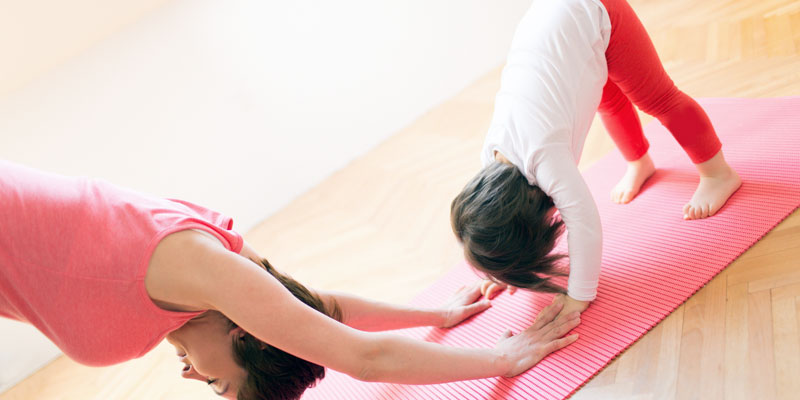
Baby Yoga Does a Body Good
Gross motor skills are movements that use either the whole body or large portions of the body together. In older kids, gross motor skills are usually developed through jumping, skipping, climbing, and similar activities. In infants and toddlers, however, these skills are characterized on a slightly smaller level: lifting her head off the floor, looking from side to side, standing up, walking, and rolling are all used as indicators of gross motor development. While these skills are important to the normal development of your little tyke, they don’t have to be all about business. It’s no secret that younger children develop gross motor skills through various forms of play and, while some vigorous play is sure to get her moving, baby yoga is another option to help develop gross motor skills in infants and younger children.
Two basic aspects of yoga are the postures and breathing. With these two simple actions, yoga can offer your baby the following benefits:
- Discovering her body. Yoga focuses on different postures and positions which will help her discover different ways her body can move. These positions aid in flexibility and strength development.
- Better breathing. Yoga involves breathing deeply and centers the body and mind through exercising full breaths. While this may not immediately affect an infant, practicing yoga throughout her younger years will aid her in breathing healthier.
- Balancing. This isn’t always easy for younger kids; their slight wobble when learning how to do different movements, such as simply walking or running, may be a constant worry and the source of a much-needed giggle from time to time.
- Bonding time. Yoga provides a bonding activity for parent and infant.
- Improving sleep. Yoga can help anyone, including your baby, sleep better.
- Observing physical development. Your baby doing yoga allows you the opportunity to witness her physical development through the different poses.
Yoga is ideal for both kids and adults, so practicing together can give you both an activity to do together while helping both of you learn to use your bodies more efficiently, become more aware through proper breathing, and become more flexible.
For infants, yoga is a way to help make them aware of their bodies, movements, and self, long before they learn to sit, crawl, or walk. According to Amy Stone, in her article, “Yoga to Bolster Baby Movement,” yoga promotes physical bonding while also stimulating growth. Starting at about 5 months old, the common yoga pose “Bridge” can be a part of your baby’s repertoire. This pose can lend greatly to her balance and discovering her feet. Downward facing dog, on the other hand, helps her realize how her body is capable of moving and discovering how her body parts are connected.
How many times have you caught your child trying to mimic your movements? It was always one of my favorite parts of the day: finding a toddler trying to copy everything I would do — even if he didn’t even realize he was doing it himself! If you think about it, you’ve probably caught your child trying to put her body exactly how you have yours. This mimicry is great for teaching yoga, especially as your baby moves into toddler-age and older, plus it can give you a much needed break from boisterous play.
Many yoga centers are now offering classes for younger children, and local libraries and community centers in your area may offer weekend or night classes. You can also check out Helen Garabedian’s book, Itsy Bitsy Yoga and its corresponding website. It’s safe, effective, and beneficial to both you and your tyke, so why not?
*This post was contributed by guest blogger Jasey Carrick.
For more information:
Public Broadcasting Service (PBS). Why Yoga and Kids Go Together. PBS Parents. Retrieved April 17, 2013, http://www.pbs.org/parents/food-and-fitness/sport-and-fitness/why-yoga-and-kids-go-together/.
WebMD. Baby Yoga (video). WebMD. Retrieved April 17, 2013, from http://www.webmd.com/parenting/baby/video/baby-yoga.
Stone, Amy. Yoga to Bolster Baby Development. Yoga Journal. Retrieved April 17, 2013, from http://www.yogajournal.com/lifestyle/1648.
Virginia Department of Social Services. Milestones of Child Development: Physical Development and Health. Virginia Department of Social Services. Retrieved April 17, 2013 from http://www.dss.virginia.gov/files/division/cc/provider_training_development/intro_page/publications/milestones/milestones_individually/08.pdf.
Development, Learning, and Inclusive Teaching Resource Centre. Gross Motor Skills. Flinders University: Development, Learning, and Inclusive Teaching. Retrieved April 17, 2013 from http://ehlt.flinders.edu.au/education/DLiT/2000/FINAL/grossmotors.htm.
Latest posts by Tania Staley (see all)
- Wishing You a Break from Life’s Little Messes on Fortune Cookie Friday - March 2, 2018
- Before Racing Off to the Weekend…Happy Fortune Cookie Friday! - February 23, 2018
- Baby Yoga Does a Body Good - May 19, 2017

+ There are no comments
Add yours